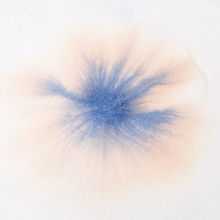Quink

Quink (a portmanteau word from 'quick' and 'ink') is a fountain pen ink developed by the Parker Pen Company. The ink was novel for using isopropyl alcohol as a solvent, which dried by absorption rather than evaporation of previous water-based inks. However the composition of the ink damaged some pen barrels and caps. The ink was later marketed with the Parker 51 pen, introduced ten years after Quink's release into the marketplace and designed to be unaffected by the chemical properties of Quink.
Background
In 1928, under the direction of Kenneth Parker, the Parker Pen Company invested three years and USD $68,000 into the development of an ink that would eliminate the need for blotting. Research for the project was headed by chemist Graham Sayler, working in a small laboratory at company headquarters in Janesville, Wisconsin. It was during the project development stage that the major discovery regarding absorption was made.
History
Quink was first marketed in 1931. The resulting product was strongly alkaline and contained isopropyl alcohol, a solvent not previously used in inks. At that time, most pen barrels and caps were manufactured of Celluloid, which was often damaged by the alcohol contained in Quink. This problem led to minor internal changes to pen existing models, using other newly-available plastics for components of their feed.
A common misconception about Quink is that it was intended primarily for the Parker 51, which generated over 400 million dollars in sales during its thirty-year history. Although Quink was indeed ideal for use with the 51, Parker's other pens of this generation were just as capable of using it. The Parker 51 was only made available in 1941, ten years after Quink's development. Two inks that were best used with the 51 specifically were the later fast-drying Double Quink and the extra-fast Superchrome.
Features

The success of Quink lay in its useful features: it had the desired quality of ink flow without clogging, it resisted water and moulding, it was non-corrosive to the metal parts of nibs and feeds, it was quick-drying, and it did not leave deposits or fade.
Celluloid materials for pens such as the Parker Duofold were becoming less common,[1][note 1] as new polymers that could be injection moulded, such as ABS and polystyrene, became popular. Parker themselves retained a range of high-end pens with the Vacumatic that still used laminated celluloid as a translucent decorative body,[2] but these no longer had celluloid parts in contact with the ink supply.
Quink was manufactured in four colors: India Black, Pan American Green, China Red and the famous Tunis Blue. It was sold in bottles made by the Armstrong Cork Company, Lancaster, PA.
The bottles were designed with a low centre of gravity to prevent tipping. The ink was to have several improvements over the years; an even quicker-drying product appeared in 1939 called "Double Quink." It included a further refinement in the addition of the chemical SOLV-X which dissolved sediment and cleaned the pen when writing.
In 1941, when the Parker 51 was launched, Double Quink was renamed and repackaged as "Parker 51 ink" for marketing purposes. Parker's ink sales became the key to maintaining the company's profitability.
Further enhancements were made to Parker inks and the company subsequently introduced "Superchrome" ink, proclaimed as revolutionary by the manufacturer. "Superchrome" ink was marketed in 1947 after a seventeen-year research period that cost over USD $200,000. Parker marketed the product as the "first basic ink improvement in over 250 years" that offered near-instant drying, greater "brilliance" (or brightness) and availability in a wider selection of colors. Superchrome ink was so quick drying that it was unsuitable for many pens, but was suited to the hooded nib of the Parker 51.
Quink is not waterproof, unlike India ink. If paper that has been written on becomes wet, black ink will run and separate into blue and yellow components.
Twenty-first century

Quink remains a popular ink product and was described as a "great all around ink" in an online fountain pen ink review. According to fountain pen enthusiasts, Parker Quink is generally considered to be "safe fountain pen ink";[3] this means that it should not stain or clog fountain pens very easily.
The use of fountain pens gradually decreased during the second half of the twentieth century. Consequently, Parker 51 ink was phased out in the United Kingdom (UK) in 1972 and the US in 1978. However, a large worldwide network of collectors and enthusiasts continue to use the Parker 51 pen in the twenty-first century, with a limited edition of the model (available in two colors, "Vista Blue" and black) released by Parker in 2002.[4] As part of the 2002 product revival, Parker promoted its quick-drying ink as the ideal accompaniment for the Parker 51.
References
- ↑ The post-war Duofold is a wholly new design, similar to the Vacumatic, and using an ABS body.
- ↑ David Nishmura. "Parker Duofold".
- ↑ David Nishmura. "Parker Vacumatic".
- ↑ Pendemonium (1995–2012). "A Few Thoughts On Fountain Pen Inks". Pendemonium. Pendemonium. Retrieved 9 June 2012.
- ↑ Ernesto M. Soler (2004–2008). "Parker". The Parker "51" Website. Ernesto M. Soler. Retrieved 9 June 2012.
Sources
- Martín-Gil J, Ramos-Sánchez MC, Martín-Gil FJ and José-Yacamán M. Chemical composition of a fountain pen ink. Journal of Chemical Education, 2006, 83, 1476–78
External links
- Glenn's Pen Page: About Fountain Pen Ink: Parker
- Quink Ink Chart (at Pentrace)
- discussion about superchrome and other Parker inks